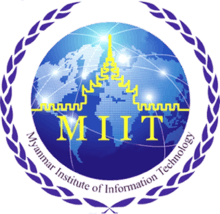Myanmar Institute of Information Technology
|
မြန်မာသတင်းအချက်အလက်နည်းပညာတက္ကသိုလ | |
| Motto | Transforming Education. Enriching Lives. |
|---|---|
| Type | Public |
| Established | 2015 |
| Rector | Dr. Win Aye |
| Director | Dr. K. R. V. Subramnian |
| Students | 352 |
| Undergraduates | 352 |
| Address | 73rd Street, Ngu Shwe Wah Street, Mandalay, Mandalay Region, 05053, Myanmar |
| Campus | Urban |
| Language | English, Myanmar |
| Website |
www |
 | |
Myanmar Institute of Information Technology (Burmese: မြန်မာသတင်းအချက်အလက်နည်းပညာတက္ကသိုလ်; abbreviated MIIT) is a technological university located in Chanmyathazi Township, Mandalay, Myanmar. It was set up in 2015 as a joint venture between the Ministry of Education, Government of the Republic of the Union of Myanmar and the Ministry of External Affairs, Government of the Republic of India. The institute has been accorded the status of a National Center of Excellence in computer science and allied disciplines. MIIT currently offers two Bachelor of Engineering (Honours) programmes in computer science and engineering (CSE) and electronics and communication engineering (ECE). It is located at the corner of the 73rd Street and Ngu Shwe Wah Street, and situated west of the Mandalarthiri Stadium and east of the Mandalay Chanmyathazi Airport.
Background
On 28th May 2012, the Government of the Republic of the Union of Myanmar and the Government of the Republic of India signed a Memorandum of Understanding (MoU) to establish Myanmar Institute of Information Technology (MIIT) at Mandalay, Myanmar. The MoU envisages that MIIT will be established and operated along the lines of the successful model of the International Institutes of Information Technology (IIITs) in India.
Based on the MoU, MIIT was created as a National Centre of Excellence of the Ministry of Science & Technology (MoST), Government of the Republic of the Union of Myanmar in 2015. MIIT started functioning as a part of the Ministry of Education (MoE) when MoST was merged to become a part of MoE in 2016.
IIIT-B has been chosen to act as the mentor institution for MIIT. It will execute the MIIT Project by building and operating MIIT, and transferring a successfully functioning MIIT to the authorities in Myanmar by December 2020.
The MIIT Project is a bilateral project between the two countries – Myanmar and India. The Government of the Republic of the Union of Myanmar will provide for the MIIT campus the building and the required infrastructure and human resources. The Government of the Republic of India will provide financial, technological, and academic assistance. This includes setting up state-of-the-art IT infrastructure at MIIT, as well as establishing academic and administrative structures and processes that enable MIIT to emerge as an institute of international repute within a short period of time. Faculty from India will spearhead the teaching efforts at MIIT through a strong, internationally comparable curriculum. They will also help in capacity building through structured faculty development programmes.
The MIIT Project aims to lay a strong foundation for MIIT to emerge as one of the top IT institutions not just in Myanmar, but in the ASEAN region. MIIT is expected to play a leading role in incorporating information and communication technologies (ICTs) into the overall development of Myanmar’s economy.
Admissions
MIIT offers admissions to various programmes to applicants solely on the basis of merit. One of the elements considered for admission is the academic performance of the applicant in the qualifying educational programme/qualifying exam. For admission to the bachelor’s degree programmes, it is the marks obtained in the qualifying examination, that is, the Matriculation Exam of Myanmar. For admission to the master’s degree programmes, the applicant’s academic performance in the corresponding bachelor’s degree programme will be one of the elements that are considered.
In addition, applicants have to appear in an entrance examination. A weighted average of the applicant’s performance in the qualifying examination and the entrance examination (conducted by MIIT) is used to create a merit list. This merit list is used to finalise the admissions.
MIIT currently offers admissions to applicants to the following programmes:
- Bachelor’s degree programmes in Computer Science & Engineering and Electronics & Communications Engineering, that is, B.E. (Hons.) in CSE and ECE
Fees and Scholarships
Bachelor’s Degree Programmes
Currently, MIIT charges tuition fees consistent with the recommendations of the Ministry of Education, Government of the Republic of the Union of Myanmar. The tuition fees charged for the bachelor’s degree programmes is approximately 25,000 MMK per semester. There are no other specific, academic fees charged.
The present tuition fee is at fairly affordable levels, and there have not been any requests for scholarships to cover the tuition fee. However, students of the bachelor’s degree programmes have to stay off-campus in Mandalay during the academic year. Extremely needy students can apply for a maintenance support scholarship. This scholarship is offered by the International Institute of Information Technology, Bangalore (IIIT-B), the mentor institution of MIIT. It is considered only for meritorious students who have documented evidence of financial distress in the family.
Postgraduate Diplomas
The tuition fee for the entire postgraduate diploma programme offered by MIIT is 500,000 MMK.
Extremely meritorious students hailing from poor families can apply for a scholarship offered by the International Institute of Information Technology, Bangalore (IIIT-B), the mentor institution of MIIT. The scholarship amount may cover the entire tuition fee, or only a part of it.
Several faculty members from other Computer Universities and Technological Universities of Myanmar also seek admission to the programme in order to strengthen their subject-matter expertise. As part of the faculty development initiatives at MIIT, jointly organised with IIIT-B, scholarships to cover the tuition fee are usually provided to selected candidates.